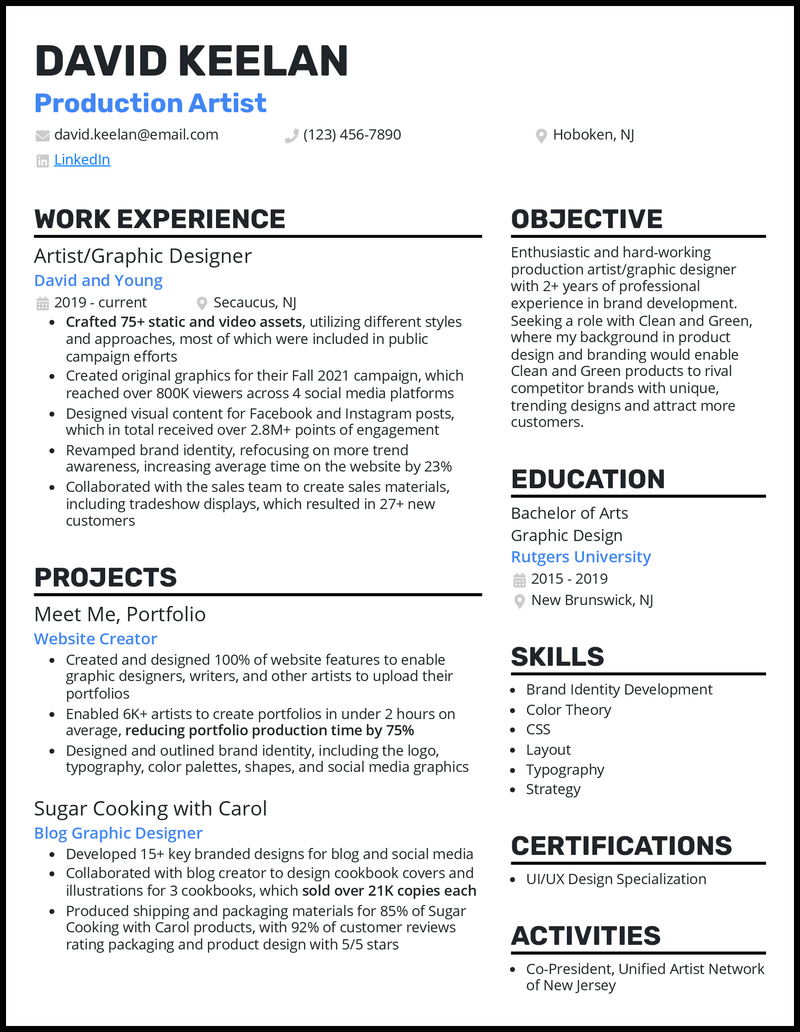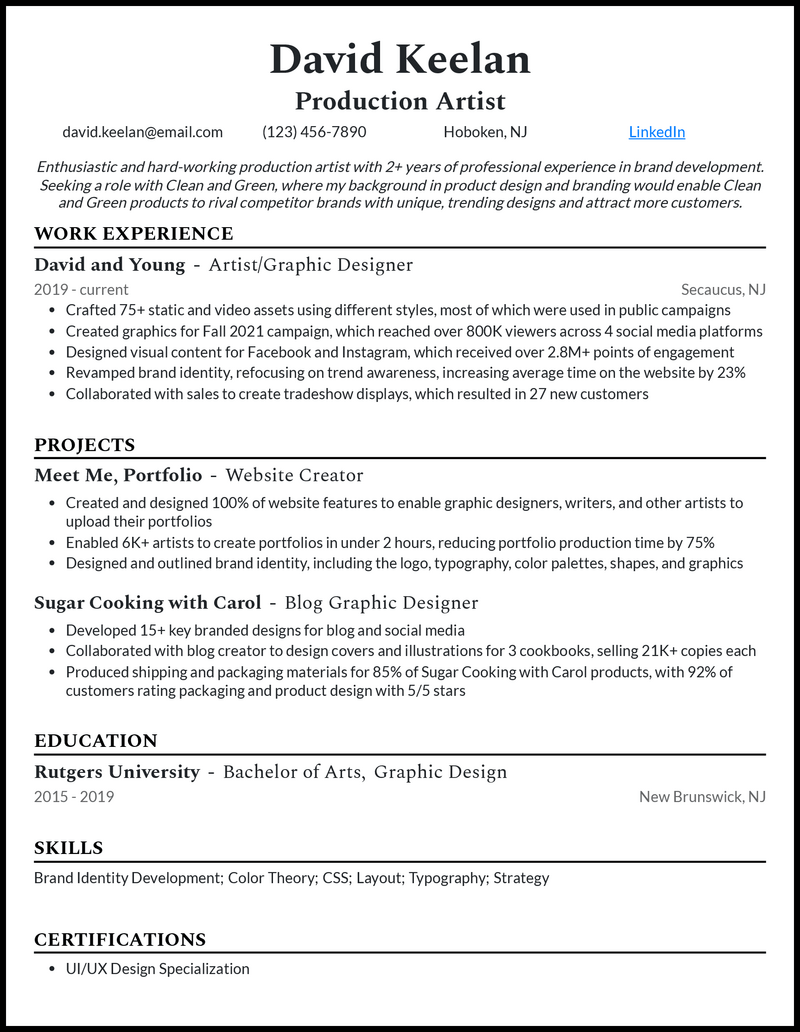You take creative concepts and graphics from the designers’ hands and push them through to finalization and production. You might advise on print layouts or web image resolutions and polish up the final products to ensure everything from website banners to print brochures looks top-notch.
However, you might have some questions about how to outline your resume and complementary production assistant cover letter before distributing it to recruiters. How long should it be, and what should your focus be?
Don’t worry: We’ve helped tons of people in your position get into the roles they’ve always dreamed of! Check out our three production artist resume templates, time-tested tips, and free cover letter builder to get started.
Why this resume works
- Your production artist resume has everything, from a killer work experience section to a perfect header, contact info, objective, education, skills, and even certifications. However, maybe you need something a little extra to showcase your leadership acumen and make it pop.
- How about adding an Activities section to your piece? Suppose you once served as the co-president of Unified Artist Network in your state. Doesn’t spotlighting that paint a picture of a team leader? Such is exactly what it takes to convince recruiters you’ve got the chops and deserve a chance.
What Matters Most: Your Skills & Background Experience

Recruiters want to know all about the tricks and tools of your trade! You want to show that you have a solid and well-rounded skill set so that they know what you can do when they start reading your employment history.
All skills on your resume should be extremely relevant to your profession. Don’t leave it at “layout” when you can specify what your strongest suits are between print and web layout! Don’t settle for “attentive” when you could say that you have an eye for detail.
And make sure you’re as specific as possible about your technical skills, too. List Adobe programs by name and utilize your knowledge of pre-press lingo.
Here’s what we mean:
9 most popular production artist skills
- UX/UI
- Adobe InDesign
- Color Theory
- Typography
- RGB/CMYK Conversion
- Proofreading
- Problem-solving
- Brand Development
- Adobe Photoshop
Sample production artist work experience bullet points
Now that you’ve provided a rundown of the skills you have, it’s time for you to show off your best memories of what you’ve achieved! Recruiters want to see how you’ve used your abilities to make a difference in previous workplaces within your field.
Think about the time you helped spot errors that would have affected the final product’s adherence to brand standards. Jot down the time you improved customer ratings with your contributions to a packaging redesign.
And always provide a measurement of your success! Error reduction rates, increases in production speed, and boosts in revenue are all good examples of quantifiable data that provide metrics for your impact.
Here are a couple of samples:
- Collaborated with blog creator to design cookbook covers and illustrations for three cookbooks which sold over 21K copies each
- Produced shipping and packaging materials for 84% of company products, with 92% of customer reviews placing packaging and product design at 4.9/5 stars
- Enabled 5.87K+ artists to create portfolios in under 2 hours on average, reducing portfolio production time by 76%
- Revamped brand identity, refocusing more on trend awareness and increasing average time spent on the website by 23%
- Collaborated with the sales team to create promotional materials, including tradeshow displays, which resulted in 27+ new customers
Top 5 Tips For Your Production Artist Resume
- Be tasteful with your own piece
- Some artists get excited at the idea of going all-out with their resume templates, but you really want to keep it simple. Think of the most modern and professional piece you polished up at work—sleek font choices and minimal sparks of color can go a long way!
- Think “resume UX”
- Apply a user-focused mindset to your resume. Alongside those super legible fonts and colors, you want your resume format to be easy to skim and understand. Production artist experience should come first, and the design internship you had in college should be at the bottom.
- Include any certifications
- If you have a certificate in a specialization like UI/UX or pre-press operations, include it on your resume! Any independent classes, workshops, or courses that conclude with certificates of achievement work, too.
- Vary your context
- When you look for the best of your achievements to include in your experience section, specifically seek out a variety of subject matter. It adds intrigue to your resume to include a diverse array of accomplishments: prints, web graphics, app buttons, and more!
- Address the job description
- Customize your production artist resume to the job ad. One company may be interested in image composition, while another may care more about your expertise in rendering 3D animations. As long as you genuinely have the skills, emphasize the skillset the company is asking for.
One page only! You’re totally familiar with all the ways you sometimes have to get creative to make things fit the proper layout. It’s the same for your resume! Make sure you stick with a single page that’s concise and appealing.
True, these are important. But soft skills are better exemplified through the context in your experience points than in your skills section. Why list them when you can show them through your collaborative efforts or empathy toward the user?
Only if it adds value to your resume. If you find you’re just talking about the same points in your experience section, ditch the redundant intro! Here’s a sample of an objective statement that speaks to the company:
Enthusiastic and hard-working production artist with 2+ years of professional experience in brand development. Seeking a role with Clean and Green, where my background in product design and branding would enable Clean and Green products to rival competitor brands with unique, trending designs and attract more customers.








